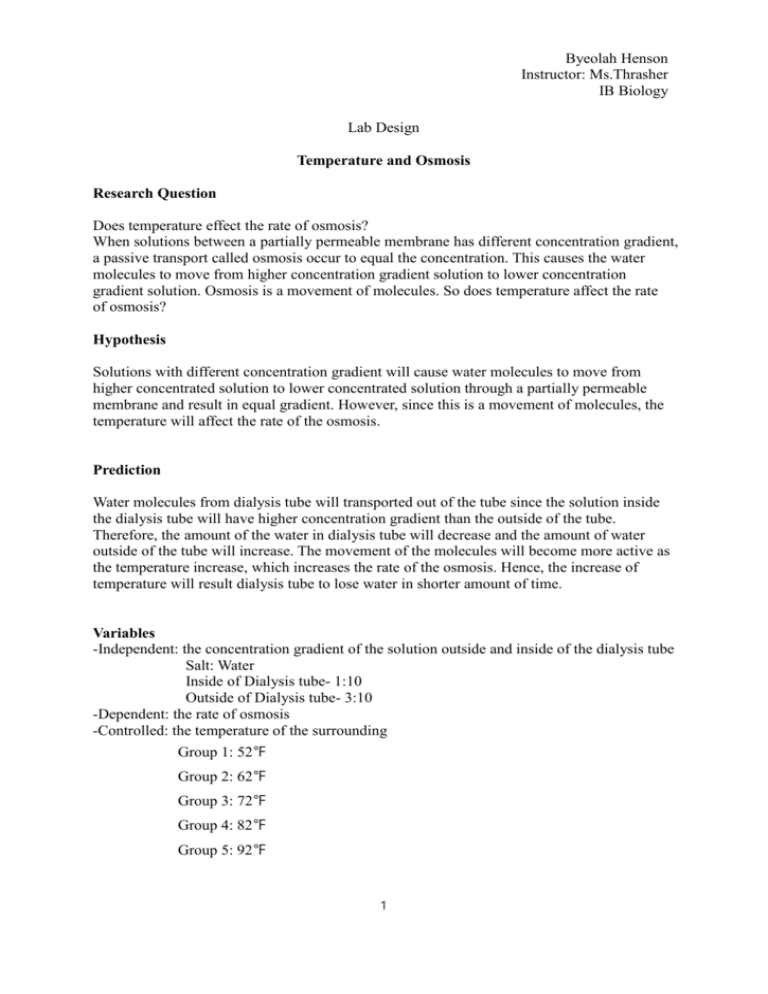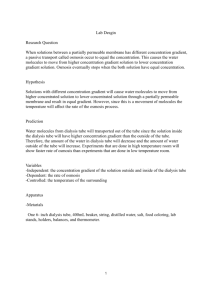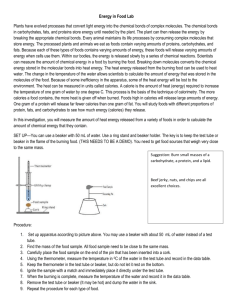IA lab design
advertisement

Byeolah Henson Instructor: Ms.Thrasher IB Biology Lab Design Temperature and Osmosis Research Question Does temperature effect the rate of osmosis? When solutions between a partially permeable membrane has different concentration gradient, a passive transport called osmosis occur to equal the concentration. This causes the water molecules to move from higher concentration gradient solution to lower concentration gradient solution. Osmosis is a movement of molecules. So does temperature affect the rate of osmosis? Hypothesis Solutions with different concentration gradient will cause water molecules to move from higher concentrated solution to lower concentrated solution through a partially permeable membrane and result in equal gradient. However, since this is a movement of molecules, the temperature will affect the rate of the osmosis. Prediction Water molecules from dialysis tube will transported out of the tube since the solution inside the dialysis tube will have higher concentration gradient than the outside of the tube. Therefore, the amount of the water in dialysis tube will decrease and the amount of water outside of the tube will increase. The movement of the molecules will become more active as the temperature increase, which increases the rate of the osmosis. Hence, the increase of temperature will result dialysis tube to lose water in shorter amount of time. Variables -Independent: the concentration gradient of the solution outside and inside of the dialysis tube Salt: Water Inside of Dialysis tube- 1:10 Outside of Dialysis tube- 3:10 -Dependent: the rate of osmosis -Controlled: the temperature of the surrounding Group 1: 52℉ Group 2: 62℉ Group 3: 72℉ Group 4: 82℉ Group 5: 92℉ 1 Byeolah Henson Instructor: Ms.Thrasher IB Biology Apparatus -Metarials One 8- inch dialysis tube, 400mL beaker, string, distilled water, salt, lab stands, holders, balances, and thermometer. -Protocol Setup 2 Byeolah Henson Instructor: Ms.Thrasher IB Biology Procedure 1) Set the room as 52° F. Check this by using the thermometer. Check the temperature every 10 minutes that the room stays in the temperature of 52° F. 2) Pour 200mL (200g) of distilled water into the 400mL beaker. 3) Pour 60g of salt into the 400mL beaker, which equals up to 3:10 concentration gradient. 4) Measure the total weight of the beaker using the balance and record 5) Tie a knot to one end of the dialysis tube and fill 100mL (100g) of distilled water in to the 8 inch dialysis tube. 6) Then, by using the balance, measure 10g of salt, and add it into the dialysis tube. This result the tube to have 1:10 concentration gradient. 7) Tie the top of the dialysis tube and measure its weight using the balance and record. 8) Tie a piece of string to the top of the dialysis tube, and drop the tube in the beaker. 9) Connect the string to the lab holders, make sure that the tube is still in the beaker water and the tube is stood up vertically. 10) Check in every 30 minutes. Take the dialysis tube out of the beaker and measure the weight of the dialysis tube, weight of the beaker without the dialysis tube, and the amount of the water in the beaker without the tube. Record. Repeat this until the solution until it does not show change anymore. 11) Repeat this 4 more times. Total of 5 trials. 12) Change the room temperature to 62° F and repeat the procedure, 2) through 11). Make sure to check the temperature of the room every 10 minutes 13) Change the room temperature to 72° F and repeat step 2) through 11). 14) Change the room temperature to 82° F and repeat step 2) through 11). 15) Change the room temperature to 92° F and repeat step 2) through 11). *Experiments must be done in a room where you can control the temperature. 3








